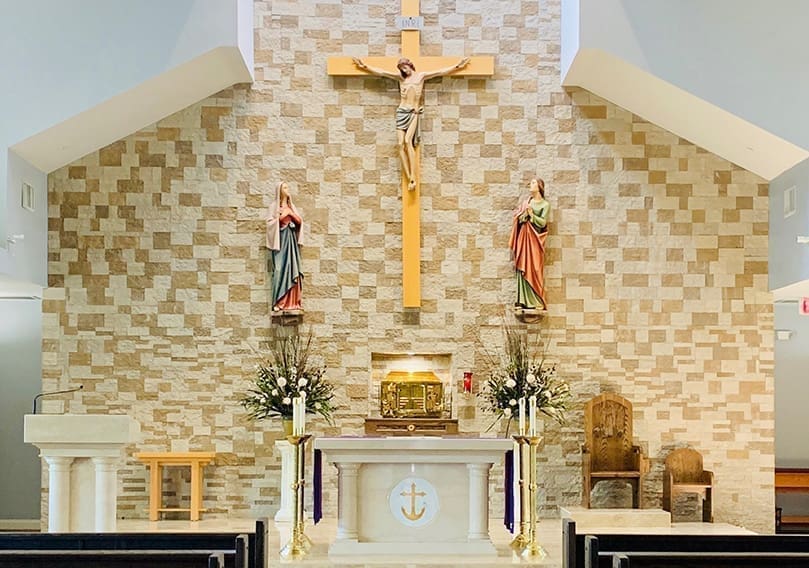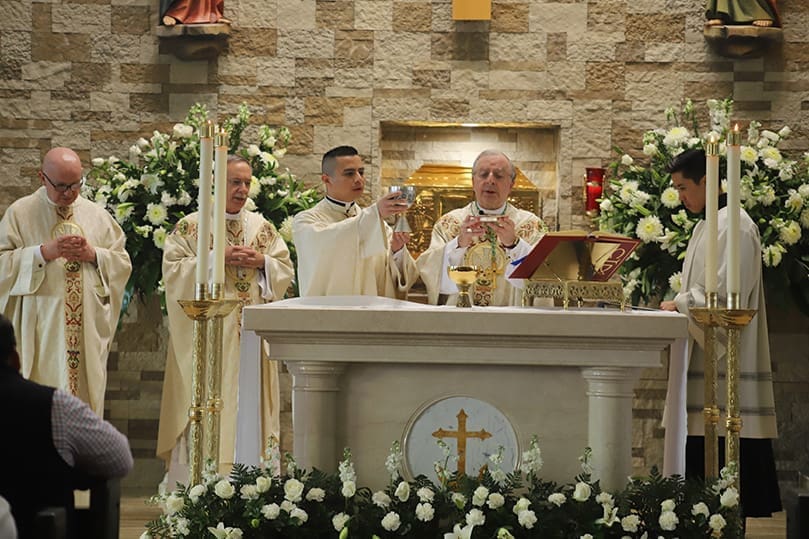 Photo by Oralia Gollaz
Photo by Oralia GollazCalhoun
St. Clement’s renovated spaces, new altar are fruits of parishioners’ labors
By IMELDA RICHARD, Special to the Bulletin | Published April 2, 2020 | En Español
CALHOUN–After many months of fundraising, the community of St. Clement Church in Calhoun gathered to participate in the consecration of a new altar Sunday, March 8. Bishop Joel M. Konzen, SM, diocesan administrator, celebrated the Mass of consecration. As a gesture of friendship to Father Feiser Munoz, pastor of St. Clement, Bishop Luis Zarama from the Diocese of Raleigh, North Carolina, and Msgr. Frank McNamee, rector of the Cathedral of Christ the King, concelebrated.
Bishop Zarama, former auxiliary bishop for the Archdiocese of Atlanta, brought Father Munoz into the priesthood from his native Colombia 14 years ago. Father Munoz’ first assignment as a priest was at the Cathedral.
“I want to thank all of you who generously gave your labor, your time and your treasure to this project. Thank you for making this happen in the life of this parish,” said Bishop Konzen as he began the celebration of Mass, which also marked completion of renovation projects.
St. Clement church is home to some 1,000 families. While many nationalities are present in the community, about half of the parishioners are of Hispanic heritage.
The renovation of the parish started in 2017 when Father Munoz was assigned as pastor. Under the guidance and leadership of both the parish and finance councils, this project began to take shape. It first started in the parish offices and expanded into the worship space. The two parish sacristies have been renovated and furnished with new cabinets, new flooring and given a fresh coat of paint. A third sacristy was removed to make more space for the congregation in the sanctuary.
The renovation of the sanctuary began in October 2018. The sanctuary area was redesigned and enlarged. The choir area was moved to the back of the church and a stage area was built for the choir. Many parishioners volunteered to paint, install the floors, refinish the pews and install a new sound system. Parish families made and honored pledges for different stages of this project and the community also organized food sales and festivals to raise funds. A new altar was donated to the parish.
Amador Granados has been a parishioner of St. Clement for the last 15 years. When he first started coming to the parish in the mid-1990s there were no services in Spanish. He has seen the growth of the Hispanic community during these years, and now the parish offers three Masses in Spanish every Sunday.
“We have a new altar, new floors and new pews. We had events and sold tacos to help raise the funds. People in our community that work in construction volunteered their time and talent to install the floors, to paint and to do whatever was needed. We might not be rich in money, but we are rich in faith,” said Granados.
A new altar
In the celebration of Mass, the sacrifice of Christ is made present on the altar. The altar is often referred to as the “table of the Lord.” At the altar, the faithful join with Christ in his work of redemption fulfilled on the cross.
The altar is also seen as a symbol of Christ. Reverence is given to the altar by bowing, use of incense, as well as the kiss given by the priest at the beginning and conclusion of Mass. These acts of reverence are meant to be reminders that the altar is a symbol of the Lord.

Concelebrating the Mass of consecration at St. Clement Church, Calhoun, were, from left to right, Msgr. Frank McNamee of the Cathedral of Christ the King; Bishop Luis Zarama of the Diocese of Raleigh, North Carolina; Father Feiser Munoz, pastor; and Bishop Joel M. Konzen, SM, diocesan administrator. Photo by Kayla Melgar
Consecration is an act by which something is separated from a common to sacred use, or by which a person or thing is dedicated to the service of God. Consecrating the altar commemorates the table is set aside for the eucharistic banquet dedicated to God.
In the early church, efforts were made to construct altars and churches over the graves of the holy ones. In modern times, pieces of relics are taken from the martyrs’ original tombs and given to new churches to be included in their altars. It is customary for a church to have a relic of the saint it has been dedicated to in their altars, and so this new altar has a relic of St. Clement.
Clement of Rome was the third successor of St. Peter and was a pope during the last decade of the first century. He is one of the church’s five “Apostolic Fathers,” believed to personally have known one or more of the Apostles or to have been influenced by them. Clement was imprisoned under Emperor Trajan. During this time, he led a ministry among fellow prisoners. He was executed by being tied to an anchor and thrown into the sea. St. Clement is the patron saint of mariners, and his feast day is celebrated on Nov. 23.
The rite of consecration started with recitation of the litany of the saints, one of the oldest prayers in the Catholic Church. It is a prayer that includes invocations for the intercession of Virgin Mary, the angels and all the martyrs and saints. It concludes with a series of supplications to God.
Bishop Konzen anointed the new altar of the Calhoun parish with sacred chrism oil, pouring it on the middle of the new altar and at its four corners. Sacred chrism is a mixture of olive oil, a symbol of richness of God’s grace, and balsam fragrance, a symbol of sweetness of Christian virtue. He then censed the altar to symbolize prayer, ascending from the altar to heaven.
“We Catholics are blessed with rich decorative arts in our churches not just as pretty extras, but as the true reflection of what we believe. The presence in our churches of statues, holy art, beautiful vessels, vestments for the celebration of the Eucharist, bells and incense and candles magnifies the very essence of our belief,” said Bishop Konzen in his homily. “With our sense of touch, sight, taste, smell, hearing, we experience the presence of God. In the Eucharist, God comes to us in the body of his son Jesus Christ to bring us life and grace. And in the center of this wonderful furnishings of our faith life stands the altar, the table of the Lord’s sacrifice. This table is now situated in our own lives, to host the banquet of life which we are always invited to.”
The Mass was a culmination of the hard work and faith of St. Clement’s parishioners.
“I want to thank God’s people, you are God’s people, you made this happen. Thank you for your generosity, for your support, for your trust, for believing in your church,” said Father Munoz to the congregation.